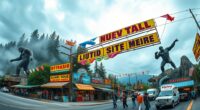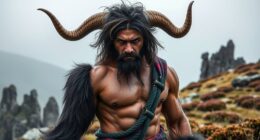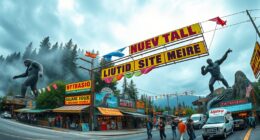Archaeological evidence shows that sightings of the Aztec Feathered Serpent, or Quetzalcoatl, symbolize divine power, celestial ties, and cosmic order. You’ll find intricate carvings, murals, and artifacts at sites like Teotihuacan and Cholula that highlight its spiritual significance. These discoveries reveal how the serpent influenced art, rituals, and political authority. Keep exploring to uncover how these sacred symbols shaped Mesoamerican culture in profound ways.
Key Takeaways
- Archaeological finds at Teotihuacan and Cholula reveal extensive feathered serpent imagery in murals, carvings, and sculptures.
- Advanced imaging technologies like ground-penetrating radar uncover hidden serpent-related artifacts and structures.
- Feathered serpent motifs symbolize divine authority, celestial connection, and cosmic order in Aztec and Mesoamerican sites.
- Ritual artifacts such as masks and figurines depict sightings and worship of Quetzalcoatl, linking archaeology to mythic experiences.
- Recent discoveries support the layered significance of feathered serpent iconography across various archaeological contexts.
Recent Discoveries in Feathered Serpent Iconography

Recent discoveries in feathered serpent iconography reveal a deeper complexity than previously understood. You’ll notice that the mythical symbolism embedded in these images goes beyond simple depictions. The feathered imagery isn’t just decorative; it signifies divine power, celestial connection, and transformation. Recent excavations uncover intricate carvings and painted murals that highlight layered meanings, showing how the feathered serpent represented more than just a deity. Instead, it embodied concepts of rebirth, strength, and cosmic order. These findings challenge earlier assumptions, suggesting a richer, more nuanced understanding of Aztec spiritual beliefs. By analyzing these detailed representations, you gain insight into how the Aztecs integrated mythical symbolism into their art, emphasizing the importance of feathered imagery in expressing complex religious and cultural ideas.
The Significance of Quetzalcoatl in Aztec Cosmology
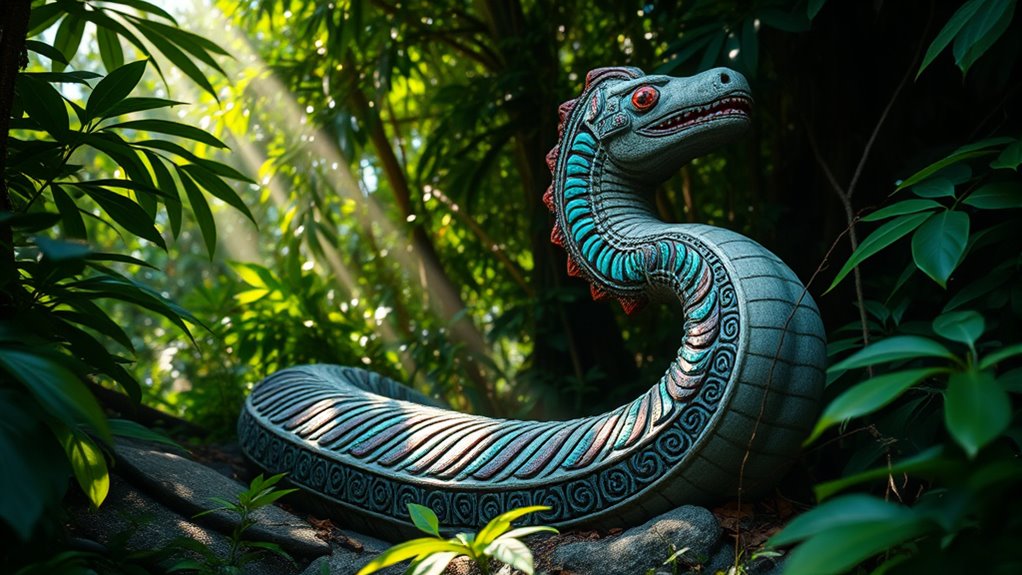
Quetzalcoatl, the feathered serpent deity, occupies a central role in Aztec cosmology as a symbol of creation, knowledge, and divine authority. You should understand that he embodies cosmic duality—representing both life and death, light and darkness. As a creator deity, Quetzalcoatl is credited with shaping the world and bringing order from chaos. His image reflects the interconnectedness of natural forces, illustrating how opposites coexist in harmony. The Aztecs believed he guided humanity’s spiritual evolution and governed essential aspects of life. Recognizing his significance helps you see how the Aztecs viewed the universe as a balanced interplay of opposing yet complementary forces, with Quetzalcoatl acting as the divine mediator and creator within this intricate cosmic fabric.
Archaeological Sites With Feathered Serpent Representations
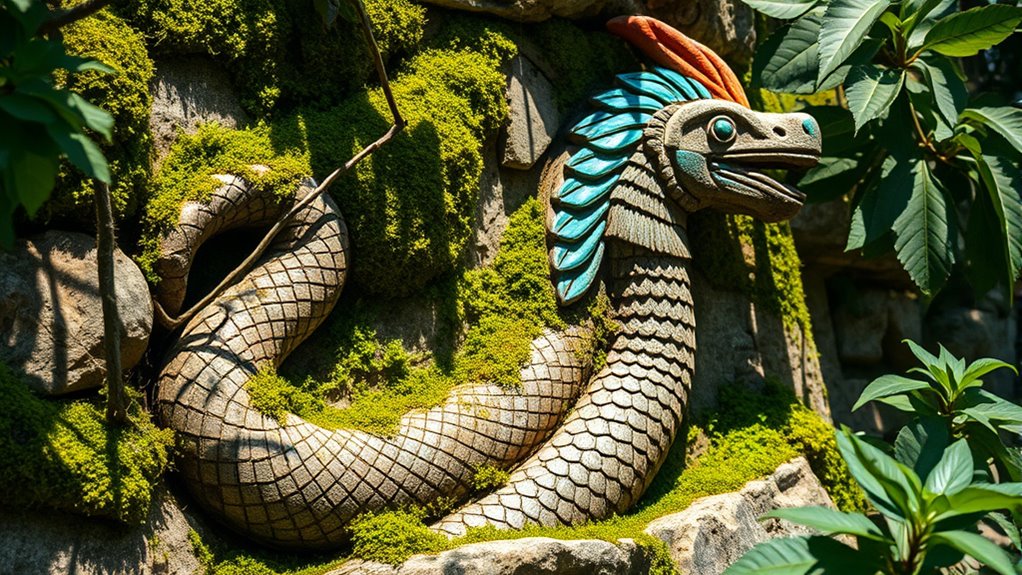
You’ll find notable feathered serpent images at Teotihuacan, where serpent iconography adorns many structures. At Cholula, sacred motifs highlight the importance of these symbols in religious practices. Exploring these sites reveals how the feathered serpent played a vital role across different cultures and periods.
Teotihuacan’s Serpent Iconography
Teotihuacan’s Serpent Iconography stands out as one of the most striking features of the site’s art and architecture, reflecting the importance of serpents in Mesoamerican symbolism. You’ll notice intricate feathered motifs that adorn murals, masks, and sculptures, emphasizing the serpent’s divine and transformative qualities. These motifs often depict serpents with elaborate plumage, highlighting their connection to celestial and earth forces. The serpent symbolism here isn’t just ornamental; it signifies power, fertility, and spiritual rebirth. As you explore the Pyramid of the Sun and the Palace of the Jaguars, you’ll see how these images reinforce the sacred narrative of life, death, and rebirth. Teotihuacan’s serpent iconography provides a vivid glimpse into the spiritual worldview that shaped this ancient metropolis.
Cholula’s Sacred Motifs
Cholula’s archaeological sites showcase some of the most compelling representations of the feathered serpent motif in Mesoamerican art. Here, divine serpents appear frequently, symbolizing fertility, power, and cosmic order. You’ll notice these sacred motifs carved into temple walls and painted on murals, emphasizing the serpent’s divine status. The intricate designs often depict the feathered serpent intertwined with other symbols, reinforcing its role as a divine messenger. As you explore Cholula’s archaeological remains, you’ll see how these motifs connect to broader religious beliefs and rituals. The prominence of divine serpents in this region highlights their significance in Mesoamerican spirituality. These sacred motifs serve as a visual language, communicating divine authority and cosmic harmony through centuries-old carvings and artwork.
Symbolism and Artistic Depictions in Aztec Artworks

In Aztec artworks, the Feathered Serpent, or Quetzalcoatl, is depicted with intricate symbolism that reflects its divine significance. You’ll notice how cosmic symbolism plays a central role, representing creation, renewal, and divine authority. Artists use vibrant colors, detailed patterns, and specific iconography to emphasize its connection to the heavens and earth. Quetzalcoatl’s feathered appearance often symbolizes the sky, while serpents evoke the earth’s power. This combination showcases artistic innovation, blending natural elements with spiritual meanings. Aztec artisans crafted images that go beyond mere decoration, conveying complex theological concepts. Their depictions serve as visual prayers and teachings, reinforcing Quetzalcoatl’s role as a creator and cultural hero in Aztec belief.
Evidence of Rituals and Ceremonies Linked to Quetzalcoatl
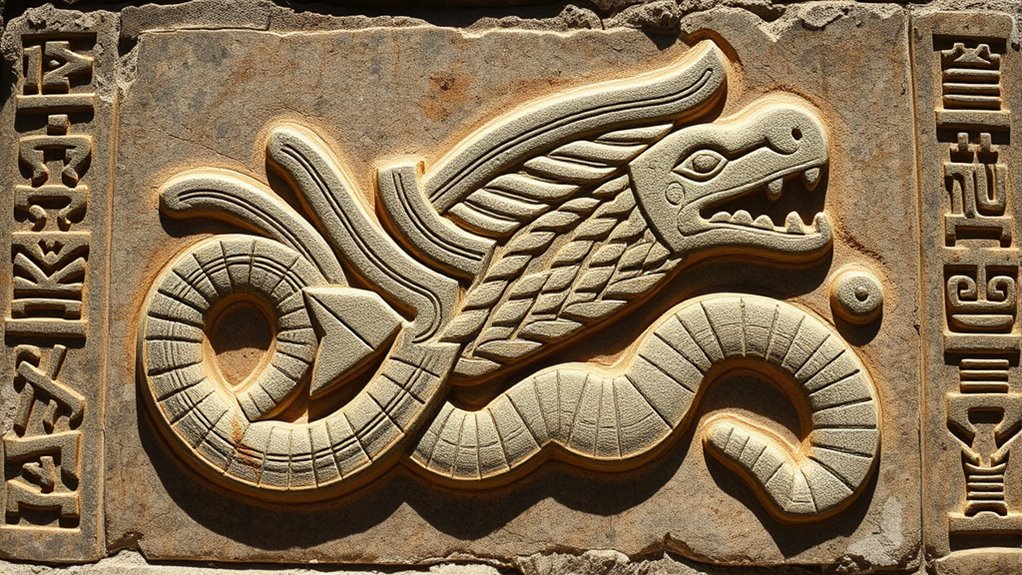
Evidence of rituals and ceremonies dedicated to Quetzalcoatl reveals the central role this deity played in Aztec spiritual life. These practices often reflect the mythical origins of Quetzalcoatl as a creator god linked to the dawn and renewal. You’ll find that ceremonial activities emphasize celestial symbolism, highlighting the serpent’s association with the sky, wind, and stars. Rituals may involve offerings, dances, and elaborate processions designed to honor Quetzalcoatl’s divine powers and guarantee cosmic harmony. Archaeological findings, such as carved stone altars and codices, provide tangible proof of these sacred ceremonies. By examining these artifacts, you gain insight into how deeply intertwined Quetzalcoatl’s worship was with Aztec cosmology and their understanding of the universe’s origins.
Interpreting the Spiritual and Mythical Sightings
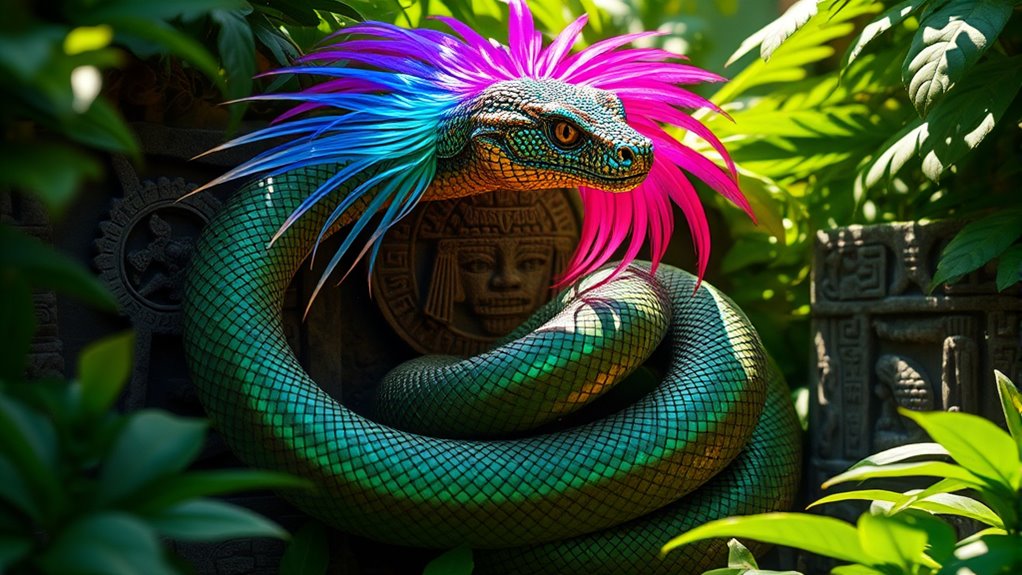
Interpreting the spiritual and mythical sightings of the feathered serpent requires understanding their deep symbolic significance within Aztec culture. These visions often reflect cosmic symbolism, representing life, renewal, and the universe’s order. To decode these experiences, consider how mythological narratives shape their meaning:
- They embody divine forces guiding human destiny
- They connect to cycles of creation and destruction
- They symbolize fertility and agricultural prosperity
- They reinforce the sacred link between humans and the cosmos
The Role of Quetzalcoatl in Aztec Political Power

You can see how Quetzalcoatl’s image served as a powerful tool to legitimize Aztec rulers’ authority. Rituals and ceremonies linked to the Feathered Serpent reinforced political messages and divine favor. By aligning myth with governance, leaders solidified their power and commanded respect across their empire.
Divine Legitimization Strategies
The Aztecs employed the figure of Quetzalcoatl to legitimize their rulers’ authority by weaving him into their political and religious frameworks. They used mythological narratives and sacred rituals to connect their leadership with divine power, reinforcing legitimacy. By claiming descent from Quetzalcoatl, rulers strengthened their divine right to rule. This strategy involved:
- Incorporating Quetzalcoatl’s image in monumental architecture
- Connecting rulers’ lineage to his myth
- Using sacred rituals to honor his divine role
- Embedding his symbolism in political propaganda
These tactics created a divine aura around the rulers, making their authority appear sanctioned by the gods. It wasn’t just political; it was rooted in sacred traditions, ensuring their position was both spiritual and worldly.
Rituals and Ceremonial Symbolism
Rituals and ceremonial symbolism played a crucial role in elevating Quetzalcoatl’s status and reinforcing the political power of Aztec rulers. Sacred rituals dedicated to the Feathered Serpent involved elaborate ceremonies that emphasized divine authority. You notice that ceremonial artifacts, such as carved masks, feathered headdresses, and serpentine figurines, serve as tangible links to Quetzalcoatl’s mythic power. These objects are used in rituals to invoke the deity’s presence and legitimize the ruler’s divine right to govern. By participating in these sacred rituals, leaders reaffirm their connection to Quetzalcoatl, positioning themselves as divine intermediaries. This symbolic practice strengthens their authority, aligning political power with divine will and embedding the Feathered Serpent deeply into Aztec religious and political life.
Political Authority Through Myth
Quetzalcoatl’s image was central to legitimizing Aztec rulers’ authority, serving as a divine symbol that connected leadership with cosmic power. This mythological authority reinforced royal symbolism, making rulers appear as divine intermediaries. You see, Aztec leaders claimed descent from Quetzalcoatl, strengthening their legitimacy. The myth reinforced that their power was granted by divine will, not just human authority. Key points include:
- The ruler’s divine right linked directly to Quetzalcoatl’s myth
- Royal symbolism emphasizing sacred origins
- Mythological authority elevating political status
- Rituals reinforcing divine connection
Comparative Analysis With Other Mesoamerican Cultures

While the feathered serpent motif appears prominently in Aztec culture, similar representations surface across other Mesoamerican civilizations, revealing shared symbolic intertwining and mythic symbolism. In Maya culture, Quetzalcoatl embodies wisdom and renewal, highlighting a different mythic nuance compared to the Aztec depiction. The Olmec also depict serpent figures, emphasizing their role as powerful symbols of fertility and cosmic order. These shared motifs underscore a common cultural language that links diverse groups through themes of divine authority, creation, and transformation. However, each civilization interprets these symbols uniquely, reflecting their specific religious beliefs and societal values. This comparative analysis reveals how the feathered serpent functions as a versatile emblem, weaving mythic symbolism into the fabric of Mesoamerican spiritual and political life.
Ongoing Research and Future Archaeological Prospects

Recent advancements in archaeology and technology are opening new avenues for exploring Aztec and other Mesoamerican sites, offering fresh insights into the feathered serpent motif and its cultural significance. With tools like drone surveys, 3D imaging, and ground-penetrating radar, you can now uncover hidden structures and artifacts related to mythical creatures and celestial symbolism more efficiently. Future research aims to:
Emerging technologies reveal new insights into Aztec feathered serpent symbolism and ancient celestial connections.
- Map extensive network of ancient pathways linked to serpent worship
- Analyze iconography to deepen understanding of celestial symbolism
- Use biomolecular techniques to identify organic remains
- Integrate virtual reality to reconstruct sites for public engagement
These innovations promise to enhance our understanding of the Aztec’s spiritual beliefs and their connection to mythical creatures, revealing how the feathered serpent embodied divine power and cosmic harmony in Mesoamerican culture.
Frequently Asked Questions
How Do Feathered Serpent Sightings Vary Across Different Aztec Regions?
You’ll notice that feathered serpent sightings show regional variations across Aztec areas, reflecting diverse cultural influences. In some regions, the iconographic diversity highlights different interpretations of the serpent’s symbolism, possibly linked to local deities or myths. These variations suggest that the feathered serpent held a flexible yet significant role, with each region emphasizing unique aspects through art, architecture, and rituals, enriching the overall understanding of its importance in Aztec culture.
What Are the Latest Technological Methods Used in Uncovering Feathered Serpent Artifacts?
You might wonder how researchers uncover feathered serpent artifacts today. Remote sensing allows you to detect hidden structures and relics beneath the surface without excavation, revealing potential sites. DNA analysis helps you identify organic materials and confirm their origins, providing deeper insights into their cultural significance. These technological methods enable you to investigate ancient artifacts more accurately, advancing your understanding of the symbolism and reach of the feathered serpent across Mesoamerica.
Are There Any Non-Mesoamerican Cultures With Similar Serpent Symbolism?
You’ll find that serpent symbolism appears in many non-Mesoamerican cultures, often representing power, rebirth, or protection. Mythological serpents like the Greek Hydra, the Norse Jörmungandr, and the Chinese Dragon showcase how different societies interpret serpents’ significance. These mythological serpents highlight universal themes, demonstrating that serpent symbolism transcends cultures, emphasizing their roles as symbols of transformation, danger, and divine power across the world.
How Do Aztec Feathered Serpent Beliefs Influence Modern Mexican Art?
You can see how Aztec feathered serpent beliefs deeply influence modern Mexican art through vibrant imagery and symbolism. Serpent symbolism remains prominent, reflecting cultural influence that celebrates both spiritual and historical roots. Artists incorporate feathered serpent motifs to honor their heritage, blending traditional themes with contemporary styles. This ongoing connection keeps the serpent symbolism alive, fostering a sense of identity and continuity in Mexican culture today.
What Challenges Do Archaeologists Face When Interpreting Feathered Serpent Iconography?
When it comes to interpreting feathered serpent iconography, you’re steering a minefield of symbolic ambiguity. Archaeologists face the challenge of deciphering these symbols amid limited context, making accurate interpretation tricky. You need to contemplate cultural, historical, and artistic factors, but often, the evidence isn’t clear-cut. This means understanding these images requires careful contextual interpretation, and sometimes, you might have to read between the lines to grasp their true meaning.
Conclusion
So, next time you spot a feathered serpent, remember you’re not just imagining things—it’s probably an Aztec conspiracy. Archaeology keeps revealing these colorful snakes slithering through history, proving that ancient civilizations really knew how to make a good myth last forever. Who needs Netflix when you’ve got Quetzalcoatl’s eternal show? Keep digging, and maybe someday you’ll see a serpent yourself—just don’t forget your archaeologist hat!


